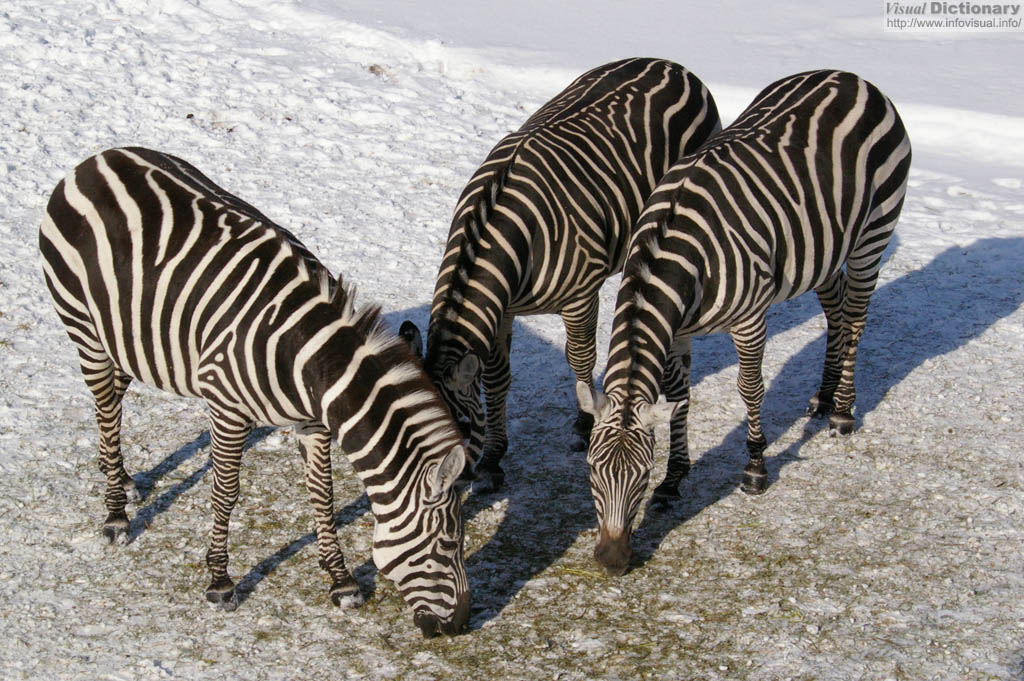Photo
Zebra

Zebras are African equids best known for their distinctive white and black stripes. Their stripes come in different patterns unique to each individual. They are generally social animals and can be seen in small harems to large herds. Zebras are generally 2.3 m (8ft) long, stand 1.25-1.5 m (4-5ft) at the shoulder, and weigh around 300kg (660 lbs), although some can grow to more than 410 kg (900 lbs). In addition to their stripes, zebras have erect, mohawk-like manes. Unlike their closest relatives, horses and donkeys, zebras have not been truly domesticated. There are three species of zebra: the Plains Zebra, Grevy's Zebra and the Mountain Zebra. The Plains zebra and the Mountain Zebra belong to the subgenus Hippotigris, but the Grevy's zebra is the sole species of subgenus Dolichohippus. The latter resembles an ass while the former two are more horse-like. Nevertheless, DNA and molecular data show that zebras do indeed have monophyletic origins. All three belong to the genus Equus along with other equids. In certain regions of Kenya, Plains zebras and Grevy's zebras coexist. Zebras might have lived in North America in prehistoric times.
The unique stripes and behaviors of zebras make these among the most familiar animals to people. They can be found in a variety of habitats, such as grasslands, savannas, woodlands, thorny scrublands, mountains and coastal hills. However, various anthropogenic factors have severely impacted zebra populations, in particular hunting for skins and habitat destruction. The Grevy's zebra and the Mountain zebra are endangered. While the Plains zebras are much more plentiful, one subspecies, the quagga, went extinct in the late nineteenth century. There are three extant species, as well as several subspecies. Zebra populations vary a great deal, and the relationships between and the taxonomic status of several of the subspecies are well known. Zebra species may have overlapping ranges, they do not interbreed.

|
This held true even when the Quagga and Burchell's race of Plains Zebra shared the same area. According to Dorcas McClintock in "A Natural History Of Zebras," Grevy's zebra has 46 chromosomes; plains zebras have 44 chromosomes and mountain zebras have 32 chromosomes. In captivity, Plains Zebras have been crossed with mountain zebras. The hybrid foals lacked a dewlap and resembled the Plains Zebra apart from their larger ears and their hindquarters pattern. Attempts to breed a Grevy's zebra stallion to Mountain Zebra mares resulted in a high rate of miscarriage. Zebras were the second species to diverge from the earliest proto-horses, after the asses, around 4 million years ago. The Grevy's zebra is believed to have been the first zebra species to emerge. Zebras are black with white stripes and their bellies have a large white blotch for camouflage purposes. These stripes are typically vertical on the head, neck, forequarters, and main body, with horizontal stripes at the rear and on the legs of the animal. |

Zebras are black or dark animals with
white stripes and their bellies have a large white blotch for camouflage
purposes. Some zebras have brown "shadow stripes" in between
the white and black coloring. Zebras are described as black with white
stripes rather than the reverse for the following three reasons:
The fact that some zebras have pure white bellies and legs is not very strong evidence for a white background, since many animals of different colors have white or light colored bellies and legs.The stripes are typically vertical on the head, neck, forequarters, and main body, with horizontal stripes at the rear and on the legs of the animal. The "zebra crossing" is named after the zebra's black and white stripes. Some zoologists believe that the stripes act as a camouflage mechanism. This is accomplished in several ways. First, the vertical striping helps the zebra hide in grass. While seeming absurd at first glance considering that grass is neither white nor black, it is supposed to be effective against the zebra's main predator, the lion, which is color blind. Theoretically a zebra standing still in tall grass may not be noticed at all by a lion. Additionally, since zebras are herd animals, the stripes may help to confuse predators - a number of zebras standing or moving close together may appear as one large animal, making it more difficult for the lion to pick out any single zebra to attack. A herd of zebras scattering to avoid a predator will also represent to that predator a confused mass of vertical stripes travelling in multiple directions making it difficult for the predator to track an individual visually as it separates from its herdmates, although biologists have never observed lions appearing confused by zebra stripes. Stripes are also believed to play a role in sexual attractions, with slight variations of the pattern allowing the animals to distinguish between individuals.A more recent theory, supported by experiment, posits that the disruptive colouration is also an effective means of confusing the visual system of the blood-sucking tsetse fly. Alternative theories include that the stripes coincide with fat patterning beneath the skin, serving as a thermoregulatory mechanism for the zebra, and that wounds sustained disrupt the striping pattern to clearly indicate the fitness of the animal to potential mates. |